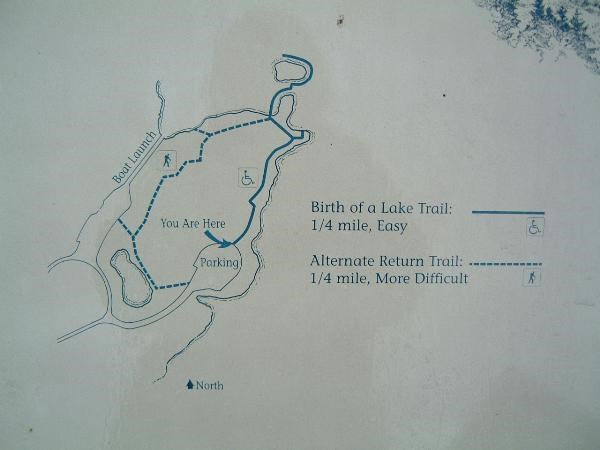Important things to know to avoid log deletion:
- if your answers will be sent at a later time, state when I will receive them in your found log.
- required photo must be personalized in some way so that I know you were truly there.
If I delete your found log due to lack of following instructions, you can re-log your find when you are able to comply.
There is no fee or pass required to park and walk to this earthcache.
At one of the places along your walk, take a moment to notice the resurgence of plants, to encounter the hopping and crawling amphibians, to get your feet wet in Coldwater Creek, or just sit quietly and ponder this place.
Here children can satisfy their curiosity by touching things along the trail borders rather than being told, "Don't touch."
The trail and boardwalk to the stated coordinates are completely stroller/wheelchair accessible as well.

Trail Map
Birth of a Lake
After Mount St. Helens' turbulent blast shattered the forest and an avalanche of rock filled the end of this stream valley, a lake began to form. Water carried rock debris and ash down South Coldwater Creek. As the stream slowed in the basin where you are now standing, the ash and debris settled, creating a “plug” at the downhill side, causing the growth of a delta and as time went by, a new lake as water pooled behind this natural dam.
As the lake continued to fill, the force of the water behind the plug had the potential to tear out the plug. This could have caused catastrophic flooding of water and debris resulting in widespread flooding and damage to downstream towns.
Workers used bulldozers and explosives to create a channel allowing a slow outflow of the water, preserving both the new lake and the towns downstream.
At first the lake was a soupy mixture smelling like rotten garbage. Methane bubbled up from the bottom. The lake seemed lifeless. Fortunately, lakes have a built-in purifying system that will automatically clean them if left alone and without further pollution.
Bacteria were busily consuming particles of organic and chemical debris. Oxygen-gulping, aerobic bacteria thrived on these nutrients and rapidly used all of the oxygen in the water. These conditions were ideal for anaerobic bacteria that live without oxygen. They quickly multiplied to take advantage of the nutrients, and millions filed each drop of water. As winter rains, wind and waves stirred oxygen back into the water, the aerobic bacteria returned to consume the remaining nutrients.
Nutrients continue to come from 19 square miles of land surrounding this lake. Rain washes fragments of plants and organic soil into the lake. Nitrogen-rich alder leaves and dead insects fall into the water. The cycle continued, and within a few years, the community of life in Coldwater Lake was similar to that found in lakes thousands of years old.
This new lake is 3 miles long and 1/2 mile wide, with a maximum depth of 200 feet. Due to the depth of the lake, only the shallow edges of the lake will sustain plant growth and convert back to forested land over time due to sediments.
In the lake there is an island which is actually a piece of Mount St. Helens. It is a hummock - a piece of the land that was blasted loose from the side of the mountain and carried along intact on a landslide. It is composed mainly of loose soil and rock. To see many more of them, walk the Hummocks Trail which starts less than a mile from here on the other side of Spirit Lake Hwy.
To claim your find for this earthcache, answer the questions below. It is best to send your answers at the same time you post your find. If, for some reason you must send answers later, include the date you will send them in your found found log. Not receiving answers or the date I will receive them may result in deletion of your find.
If more information is needed or questions need to be answered, you will be contacted promptly.
Questions to answer - preferably through the message center. Responses from the CO will be through the message center. Cut and past the questions and include them with your answers so that I know which earthcache you are referring to:
1. Look at the water in the lake both in the distance and looking straight down over the railing's edge. Does either location have color? When you look down, is there color to the water or are you simply seeing the bottom through clear water? What would be the reason for the colors you observe both in the distance and looking straight down?
2. Look at the hummock. Using the depth of the lake from the cache text, suggest how tall is it overall - from the base underwater to top above water? What changes to it would you expect to see over time?
3. Describe one thing you experienced during this visit, apart from the lake and the hummock, that is related to the eruption years ago.
4. How long did it take for microorganisms to create clear water in this lake? (this is on a readerboard at one of the alcoves.)
5. For kids only – How did the lake get its name?
6. Required to keep your found log in place. A photo of you at the overlook with the hummock in the background. If camera shy, hold up a name tag or your name written on a piece of paper.
I hope you enjoyed your time here.